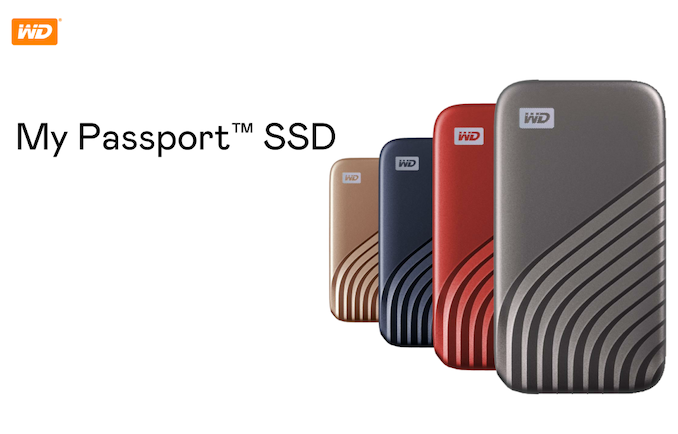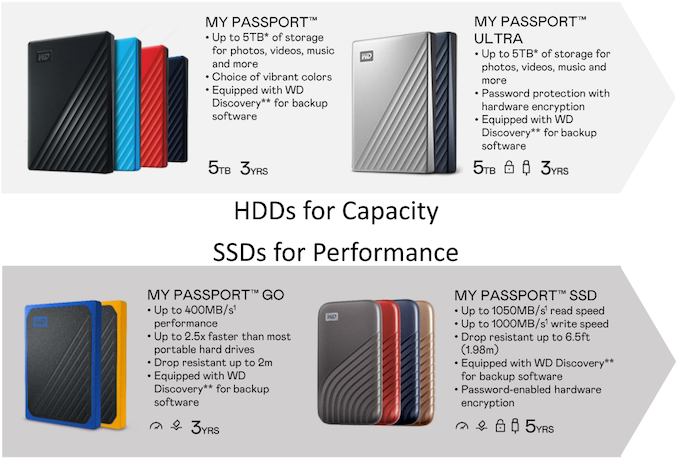Western Digital's USB 3.1 Gen 2 WD My Passport SSD Gets an NVMe Refresh
by Ganesh T S on August 20, 2020 8:00 AM EST- Posted in
- Storage
- SSDs
- Western Digital
- DAS
- Type-C
- My Passport SSD
- USB 3.1 Gen 2

Western Digital's lineup of direct-attached storage (DAS) products targets a range of markets and form-factors. After the acquisition of HGST / G-Technology and SanDisk, the company now offers similar products under multiple brand names. Portable bus-powered SSDs are an example. Subtle differences in the feature sets of the products enhance their appeal to the brand's target market.
Late last year, the WD_Black P50 was introduced as the fastest non-Thunderbolt portable SSD in the market, thanks to its USB 3.2 Gen 2x2 interface. The branding clearly indicated that gamers were the target market. The regular WD branding is reserved for the My Passport series. We reviewed the first model in the My Passport SSD series back in 2017. It used the planar TLC-based SanDisk X400 M.2 SATA SSD internally with a USB 3.1 Gen 2 Type-C host interface. A new version of the My Passport SSD was released the following year with a WD Blue 3D NAND SATA SSD using 64L 3D TLC flash. Both products were held back performance-wise by the use of a SATA SSD. Today's product launch brings NVMe into the picture for the My Passport SSD product line.
The WD My Passport SSD targets productivity use-cases for business professionals (including certain content creators). The new version's industrial design and appearance has changed, with the sharp corners and fully-plastic enclosure now replaced by an aesthetically-pleasing partial metal enclosure having rounded corners. WD claims that the new design feels less rigid and more portable, and has a more pocketable shape overall.
While the WD_Black P50 and the SanDisk Extreme Pro portable SSDs meant for huge games and large media files used the WD Black SN750 NVMe SSD internally, the new WD My Passport uses the DRAM-less WD Blue SN550 NVMe SSD. This still uses a PCIe 3.0 x4 interface, and the performance numbers for the 500GB+ models are good enough to saturate a USB 3.1 Gen 2 interface. Hardware encryption is one of the key features of the higher-end products in the My Passport line-up, and the new My Passport SSD also supports AES-256 for data protection without performance loss.
The WD My Passport SSD 2020 provides a huge leap in performance (up to 1050 MBps) compared to the 2018 version (540 MBps). The 256GB capacity SKU has been phased out, and only three capacities are going to be offered - 500GB ($120), 1TB ($200 - WD's MSRP is $190), and 2TB ($380). While the My Passport SSD 2018 was available only in a single color (gray/black), the 2020 version is available in four colors - gray, red, blue, and gold.
The SanDisk Extreme Pro Portable SSD is our current favorite when it comes to USB 3.1 Gen 2 portable SSDs, thanks to its compact design, performance consistency, and thermal performance. Power consumption (particularly at idle) was one of its Achilles heels compared to the OWC Envoy Pro EX USB-C (which provided similar performance, albeit in a slightly larger form-factor). If the WD My Passport SSD manages to reach close to the SanDisk Extreme Pro's performance profile while also optimizing power consumption, Western Digital may end up with yet another compelling offering in the portable SSD market.
Source: Western Digital













20 Comments
View All Comments
Valantar - Friday, August 21, 2020 - link
For devices like this, type C is replacing micro-B 3.0, not type A. Which is not only a much newer connector than type-A, but also one of the worst connectors ever designed. It's like it's made to break! Much too flat and wide. Type-C is undoubtedly still more expensive, but honestly, that extra $1 on the BOM and slightly more complex PCB really shouldn't result in a $30-50 premium.PaulHoule - Friday, August 21, 2020 - link
Not at all sure that USB-C is "durable". I haven't had any connectors fail outright but frequently they don't always seem well attached to their circuit boards. There is something undocumented and rotten about USB 3.0, you might think you can plug a device into a hub and plug the hub into a hub and plug that into your computer, and you can, but if it gets any more complex than that, it gets hairy in practice and looking at the standard docs it is not clear exactly what it is promising, if anything.Valantar - Friday, August 21, 2020 - link
Is that really something you would expect, at least while still maintaining high speed data transfer? Remember, even USB 2.0 only worked up to cable lengths of 5m, with anything above 3m frequently being problematic for things like printers. The shorter cable runs of higher speed interfaces is an issue, definitely, but it's also an unavoidable consequence of more complex signalling. And one shouldn't confuse a hub for a signal redriver.Valantar - Friday, August 21, 2020 - link
As for type-C connectors not being well connected to their PCBs... is that the fault of the connector design or the OEM? I've had quite a few micro-B connectors break off the PCB, which is what type-C mainly replaces, and type-C being slightly bigger and having more solder points ought to make it attach better IMO.AnarchoPrimitiv - Saturday, August 22, 2020 - link
Just buy a USB 3.1 gen 2 enclosure for $25 and an m.2 nvme SSD now, and save yourself some money. I just got an HP EX950 1TB NVMe for $125, and that's one of the fastest consumer drives on the market (new firmware has it beating the Adata SX8200 pro and 970 EVO), you could easily buy an Intel 665p 1TB for about $100 which will still easily saturate the USB 3.1 gen 2 connection, all for about $125 with enclosure includedepobirs - Thursday, August 20, 2020 - link
This reminds me that I've yet to see a definitive answer from Microsoft whether 10Gb mode will be supported by the USB ports on the Xbox Series X. It would be a big improvement for Xbox One and older games without taking up space on the internal SSD.PeachNCream - Friday, August 21, 2020 - link
I'm also interested in finding out an answer to that question given the size of modern games and the high odds we are going to see an increase in storage demand with the next console generation.Johnathan - Friday, August 21, 2020 - link
Where is the link where this product is sold ?Why the heck is it so expensive ? who need an extreme nvme inside this 1GB/s enclosure , the extreme nvme only gives more performance in the range of 3-4 GB/s in the pcie interface .
AnarchoPrimitiv - Saturday, August 22, 2020 - link
I don't understand why people buy these when you can buy your own 1TB m.2 nvme drive for about $100-$125 (Intel 665p floats around $100, I bought an HP EX950 1TB for $125 and it's one of the fastest TLC drives on the market), then just buy a USB 3.1 GEN 2 enclosure for $25.one that's more durable, better looking and smaller than these, remove one screw, if at all, and boom, you have your own external SSD for about $50-$75 cheaperTomatotech - Tuesday, August 25, 2020 - link
Buying for work. I've built many computers at home, but if I'm buying for work, they don't pay me to fiddle about with that shit. It's all in one or nothing for work. Also easier to explain / return when something goes wrong.Plus it becomes company property and may be passed to another colleague for use later. I don't want them thinking I built something weird - colleagues my boss and the company will then regard it my fault when it breaks / behaves normally but they think its broken.